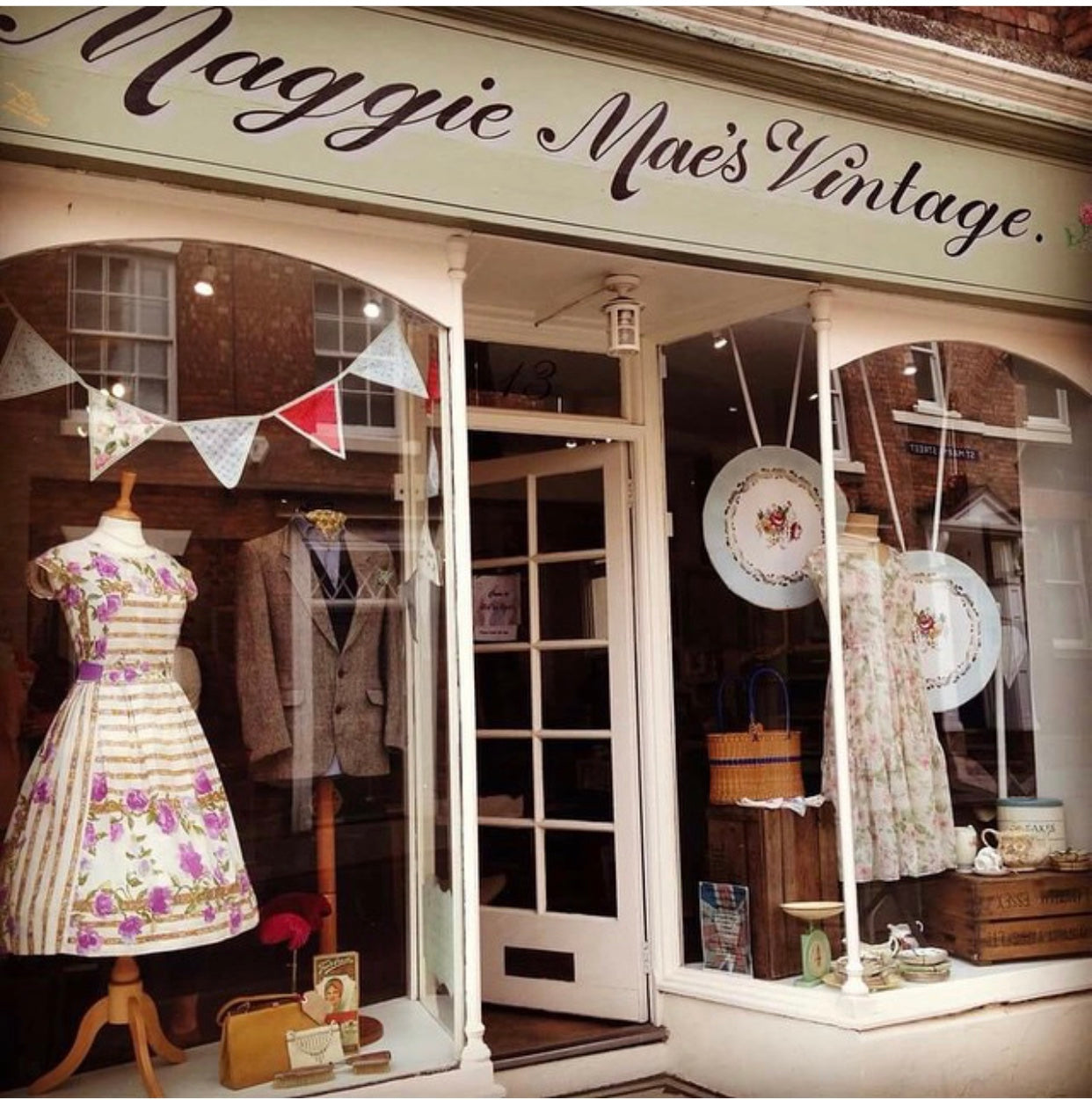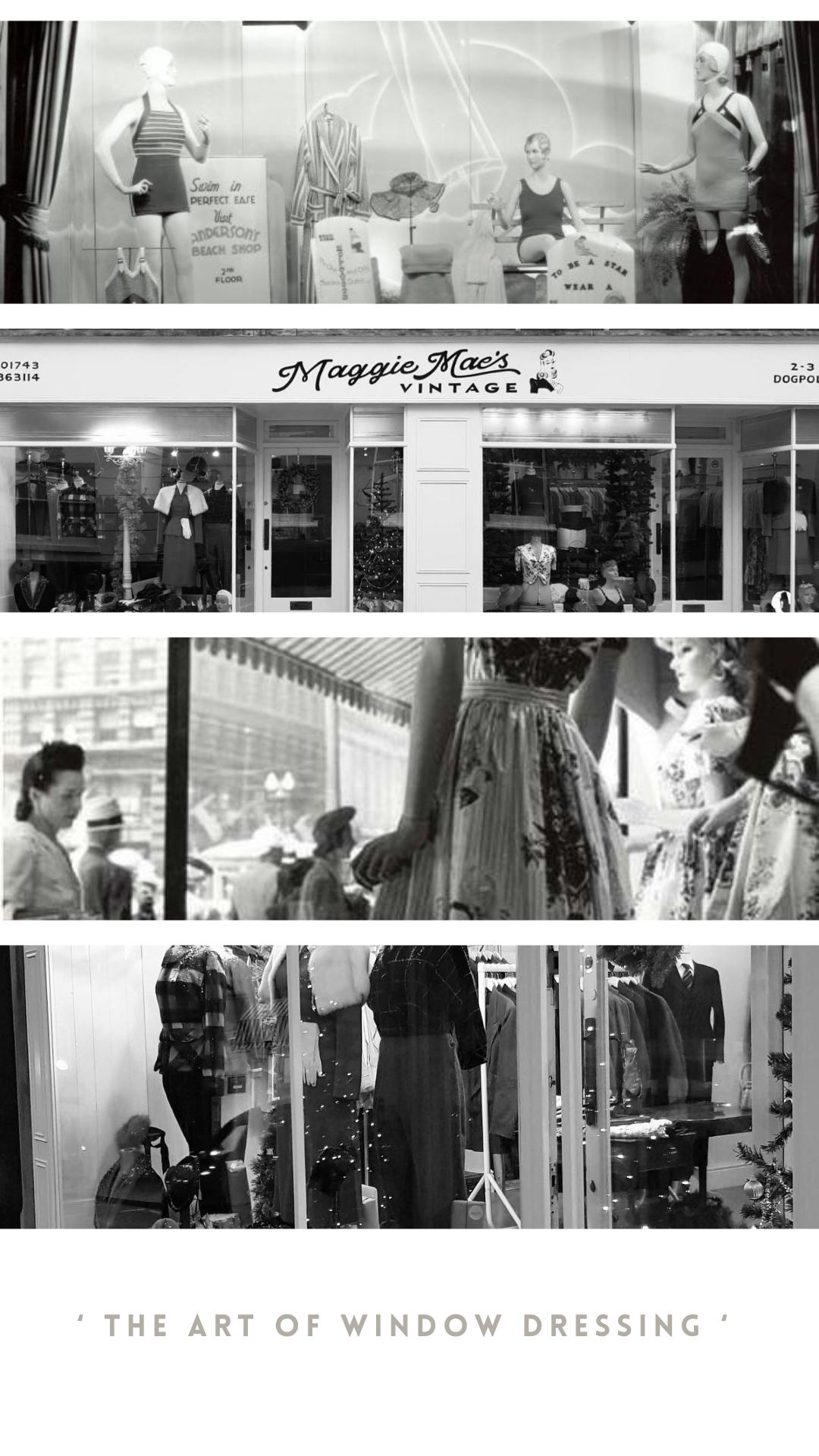
The Art of Window Dressing
My love of window dressing or trimming a window display comes from the periods and eras I love so much. I always long for the glamour, style, magic and theatrical displays that I see in old archive photographs, films and advertisements. Window displays are the forefront of any business and I love standing infront of a display and being captured and enammered by its beauty. There is something magical about seeing individual pieces being given life like qualitties in a display to show the way in which it can be used or worn. I long for the displays of the past to come back to the forefront of modern day visual merchandising to bring the sparkle and theatre back to the 21st century high street windows.

Definition of ' A Window Dresser '
' A Window Dresser - Window Dressers or Window Trimmers arrange displays of goods in shop windows or within a shop itself. Such displays are themselves known as window dressing. Window dressers modernly renamed as 'visual merchandisers' showcase merchandise, products and goods in windows to the best market and commercial advantage. They may work for design houses, work for the store or it may be there own business.'

The History Of Window Dressing
An art form that highlighted its need and lust for emerging in the 18th and 19th centuries where the evolution of shopping soared with the faster turnover of ' fashionable goods' and the increase in department stores stocking and selling these goods. The shops pioneered new techniques of window display rather than stockpiling goods and stacking them full to bursting in window displays and shelves which were common sights in markets and bazars of the time. They became aware of creating displays in mannered and conscious ways, showcasing particular items and ways in which you would use them which in turn helped to sell ' non - essential goods'.
By the 19th Century stores with small paned window glass fronts or boarded and bricked facades were opened up and replaced with single paned large floor to ceiling window panels. Gas lighting posts started to dominate the streets outside the rows of store fronts and made window displays start to come alive and be seen in the evenings.
Department stores created a new display aesthetic and introduced lifelike room settings with mannequins and props. They created narratives and themes to tell stories rather than stockpiling goods for visual impact. The new display aesthetic put the products into context and shared the practicality/ styling and price of the non essential goods displayed in the arrangement. Displays started to include mannequins, stands and fixtures to enhance the aesthetic. ' Unfashionable Goods' , food produce and more continued to be stockpiled high in windows creating messy and unloved displays.
Otherwise known as open displays first developed in America, where the art of the window display became more known professionally in the late 19th Century. L. Frank. Braun, who later wrote the Wizard of Oz, created the first journal in the art called ' The show Window' in 1897. He founded the National Association of Window Trimmers in 1898 which raised awareness of the art and saw the raised status of the window trimmer/ window dresser promote its artists to Display Managers throughout the industry.
The new approach reached England in 1909 where Gordon Selfridge, Friend of L. Frank Braun and his display manager Ernst Goldsman began a new venture. They both worked in Chicago in Marshell Fields Department store in the 1890's. Selfridges department store opened in 1909 and had the longest and biggest shop façade ever seen in Great Britain. The shop received instant fame and praise for their display work. shoppers and passers by glared in amazement at the American style dressings with life like scenes, wax mannequins in real life poses and the latest fashions and notions. Selfiridge was known as ' The Showman of Shopping' his window displays were the first displays to be lit in the evenings. His displays oozed theatricality and crowds would gather at any time of the day to see the spectacles.
World War Two halted the development and progress of the ever expanding art that is window dressing and it didn't really find its feet again once shops resurfaced until the 1960's where designers and artists embarked on blending there work to create an overall balanced window, food retailers then joined the craze and introduced pop art into there window selections.

Iconic Window Dressing






( Images Taken From Various Archives For Selfridges, London between 1920 and 1944)
Our Window Displays
Our window displays play homage to the displays from the past but echo some of the modern day visual merchandising from 21st century training. We try to keep the windows as authentic as we can within our means and often create displays with a theme or event in mind which is how they would have started their displays in the past. While we long for period accurate mannequins we style all our garments on tailors dummies to showcase the silhouettes. We try to incorporate both original and reproduction pieces into our new lifestyle windows since moving to our larger shop premises. Our displays try to show you ways in which pieces can be worn together to create an authentic ensemble with both garments and accessories. Our eagerly anticipated Christmas Windows are the highlight of the display calendars year and we go to town with extra props and styling settings for a truly authentic Showcase and magical experience.


Tips and Tricks
Whilst we aren’t experts and haven’t had formal visual training we do have some hints and tips that we use ourselves to help us in creating eye catching displays. We start by identifying key pieces we want to be featured in the weeks display. We then build on this by by creating flatlays for accompanying accessories and other garments to be featured. We try to incorporate different garment types, original and reproduction pieces and a key tip is to layer. Layering creates different eye catching points of interests. As well as layering building textures and heights keep the windows interesting and draws the customer or onlookers eyes to different pieces. Whilst not every 2 week display changeover will be based on a theme or event we still try to keep the designs cohesive, whether that there be a link with colours, eras or season. It is really helpful before you start to clear any existing pieces and clean so you are starting with a blank canvas, creating a display is like creating a piece of art and as such a blank clean space is much easier to work with. If you are using larger props or pieces of furniture it’s best to get these placed first and build your display around them. It is always a good idea to keep a visual kit with you for the window trimming. Must haves for our kit include; Sewing Pins, Iron, Ironing Board, Fishing Wire, Clothes Pegs, Lindt Roller, and a tape measure. For us our windows are our showcase and we try to make the garments come alive in our displays as if they were being worn from that period. Time is a key factor for creating a new display, you have to allow time to keep checking how the display is looking from outside the shop, to make sure all the key details are on show and catch your eye.
Our showcase windows may take up to 4 day’s to complete whereas fortnightly displays are often achieved and completed in a day. When creating our showcase display we also create sketches and mood boards to help finalise plans and ideas which helps you visualise the piece from your mind.
Our showcase windows may take up to 4 day’s to complete whereas fortnightly displays are often achieved and completed in a day. When creating our showcase display we also create sketches and mood boards to help finalise plans and ideas which helps you visualise the piece from your mind.

Our Favourites
Maggie’s favourite window display to adorn our windows was a beautiful showcase created for the Shrewsbury Flower Show, we had previously won the best dressed window competition in April 2015 and Maggie’s Favourite display was from April 2016. She particularly loved the display due to its homage to the world wars and beautiful showcase of fresh flowers mixed with vintage.

Megan’s favourite showcase is a more recent creation from the first ever Christmas window in the new shop. The display was created in November 2019 and depicted a winter wonderland alongside an evening out for festivities. Megan’s love of this window was because she felt the display created such a magical image and the garments really came alive with the use of extra props and lifelike snowfall.

Shop Gallery
A few photos from our timeline of window displays from the opening of our shop in 2013 at 13 Dogpole, Shrewsbury and our current address at 2-3 Dogpole, Shrewsbury.

( Our Prize Winning Entry in April 2015 for the Shrewsbury Flower Show Competition )











We hope you enjoyed reading our snippet of ‘ The Art Of Window Dressing’, whilst we could happily talk vintage, displays and fashion history all night long we will leave you with this. Keep finding the magic and storytelling in shop windows as you walk down your local high streets and enjoy the notions and nods to the art form which started so long ago.
Happy Shopping
Maggie & Megan x x

7 comments
Wow, never knew there was so much to learn about window dressing! I’ve always been so impressed with pictures of them from the past. And of course your shop windows always look fantastic and help with ideas of how to put outfits together.
What a wonderful insight to the history of window dressing. We visited your beautiful shop at one of your workshops last year. You both do such fabulous displays, it’s like looking at a beautiful piece of art ❤️